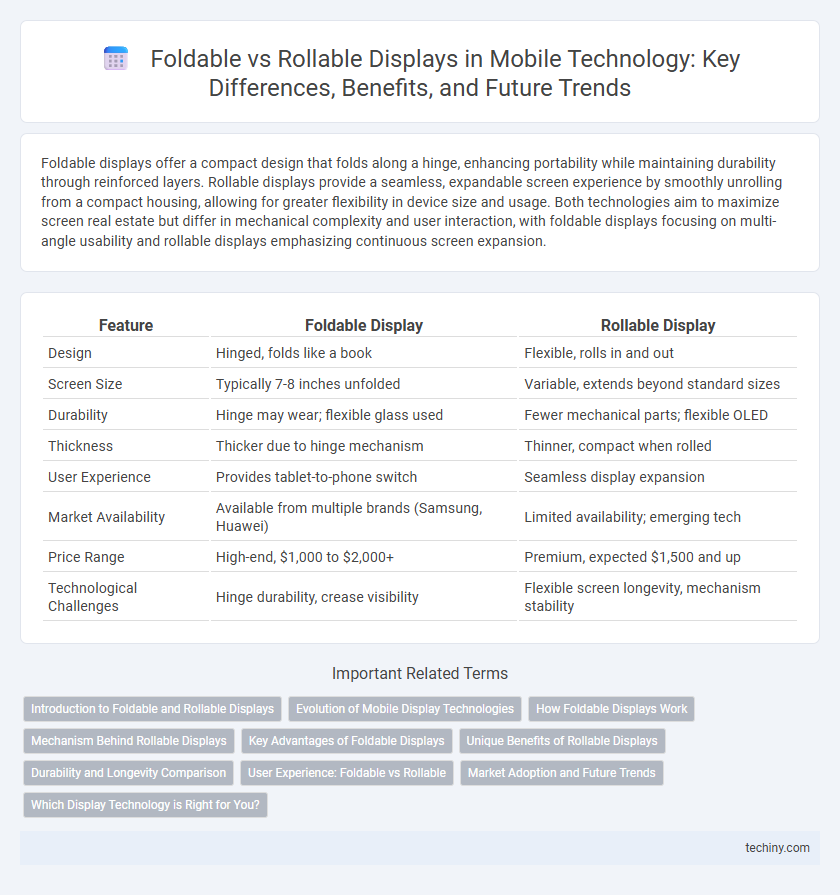Foldable displays offer a compact design that folds along a hinge, enhancing portability while maintaining durability through reinforced layers. Rollable displays provide a seamless, expandable screen experience by smoothly unrolling from a compact housing, allowing for greater flexibility in device size and usage. Both technologies aim to maximize screen real estate but differ in mechanical complexity and user interaction, with foldable displays focusing on multi-angle usability and rollable displays emphasizing continuous screen expansion.
Table of Comparison
| Feature | Foldable Display | Rollable Display |
|---|---|---|
| Design | Hinged, folds like a book | Flexible, rolls in and out |
| Screen Size | Typically 7-8 inches unfolded | Variable, extends beyond standard sizes |
| Durability | Hinge may wear; flexible glass used | Fewer mechanical parts; flexible OLED |
| Thickness | Thicker due to hinge mechanism | Thinner, compact when rolled |
| User Experience | Provides tablet-to-phone switch | Seamless display expansion |
| Market Availability | Available from multiple brands (Samsung, Huawei) | Limited availability; emerging tech |
| Price Range | High-end, $1,000 to $2,000+ | Premium, expected $1,500 and up |
| Technological Challenges | Hinge durability, crease visibility | Flexible screen longevity, mechanism stability |
Introduction to Foldable and Rollable Displays
Foldable displays use flexible OLED technology to enable screens that bend along a hinge, allowing devices to transform between smartphone and tablet sizes. Rollable displays utilize a flexible substrate that can extend or retract smoothly without visible creases, offering a seamless expansion of the screen area. Both innovations leverage advanced materials like polyimide and flexible thin-film transistors to deliver durable, high-resolution visuals on compact mobile devices.
Evolution of Mobile Display Technologies
Foldable displays revolutionize mobile technology by enabling devices to transform between smartphone and tablet modes using flexible OLED panels, enhancing portability and multitasking capabilities. Rollable displays advance this evolution further, featuring extendable screens that slide out from a compact form, maximizing screen real estate without increasing device size. Continuous innovations in materials science and hinge mechanisms drive the shift from rigid to adaptive mobile screens, fostering new user experiences in productivity and entertainment.
How Foldable Displays Work
Foldable displays use flexible OLED (Organic Light Emitting Diode) technology that allows the screen to bend along a hinge without damaging the pixels or display layers. These screens are constructed with ultra-thin glass and plastic substrates, enabling multiple folding cycles while maintaining image quality and touch responsiveness. This innovation supports devices like foldable smartphones, which transform from a compact phone into a larger tablet-sized screen, enhancing portability and user interaction.
Mechanism Behind Rollable Displays
Rollable displays utilize flexible OLED panels that unspool from within the device's chassis using motorized or spring-loaded mechanisms, enabling a seamless expansion of the screen size. This technology relies on advanced polymers and thin-film encapsulation to maintain durability and minimize pixel distortion during repeated rolling. Unlike foldable displays, which hinge at fixed points, rollable displays offer a continuous, smooth surface that enhances user experience by reducing crease visibility and increasing mechanical reliability.
Key Advantages of Foldable Displays
Foldable displays offer enhanced portability by allowing larger screen sizes to collapse into compact forms, improving user convenience without compromising on display area. Their hinge technology provides durability and multiple usage modes, supporting seamless multitasking and immersive media consumption. Foldable displays also benefit from established manufacturing processes, resulting in better availability and optimized performance compared to emerging rollable display technology.
Unique Benefits of Rollable Displays
Rollable displays offer unparalleled portability by expanding screen size without increasing device thickness, enabling seamless transition from compact to tablet-sized interfaces. Their flexible design reduces mechanical stress compared to foldable displays, enhancing durability and lifespan. This innovation also allows for a continuous, crease-free viewing experience, optimizing media consumption and user interaction.
Durability and Longevity Comparison
Foldable displays utilize flexible OLED panels with reinforced ultra-thin glass, offering enhanced resistance to scratches and moderate bending stress, while rollable displays rely on more flexible plastic substrates that enable seamless rolling but remain more susceptible to damage from repeated bending and environmental factors. Durability tests indicate foldable phones can withstand approximately 200,000 folds, emphasizing longevity through robust hinge mechanisms and impact-resistant layers, whereas rollable devices face challenges in maintaining screen integrity over prolonged use due to delicate rollable components. The longevity of foldable displays currently exceeds that of rollable displays, positioning foldables as a more reliable choice for consumers prioritizing device lifespan and durability in advanced mobile technology.
User Experience: Foldable vs Rollable
Foldable displays offer a durable, multitasking experience with clear screen divisions ideal for productivity, while rollable displays provide seamless, expansive viewing without creases, enhancing media consumption and portability. Users benefit from foldables' robustness and app continuity, contrasted by rollables' innovative form factor that maximizes screen real estate in a compact device. Both technologies prioritize flexibility and immersive interaction, but foldables excel in practicality, whereas rollables lead in futuristic design and user adaptability.
Market Adoption and Future Trends
Foldable displays have gained significant market adoption due to established manufacturing techniques and consumer familiarity, with major brands launching several models driving sales growth in the smartphone sector. Rollable displays, while still emerging, promise enhanced design flexibility and larger screen real estate but face higher production costs and technical challenges that limit immediate market penetration. Future trends indicate increasing investment in rollable technology research, with potential breakthroughs expected to accelerate adoption and expand applications beyond smartphones to tablets and wearable devices.
Which Display Technology is Right for You?
Foldable displays offer a robust, versatile design with creases that allow smartphones and tablets to transform into larger screens, ideal for multitasking and gaming. Rollable displays provide a seamless, bendable screen that extends horizontally, delivering a sleek, futuristic experience perfect for users valuing portability and uninterrupted visuals. Choosing between foldable and rollable display technology depends on your preference for durability and compactness versus flexible, continuous screen real estate.
Foldable display vs rollable display Infographic

 techiny.com
techiny.com